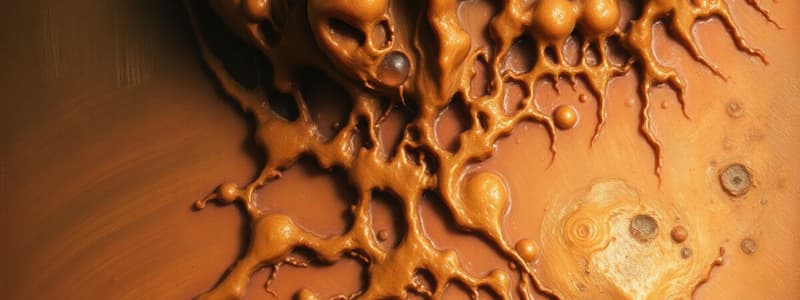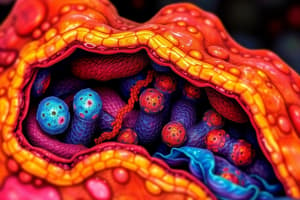Podcast
Questions and Answers
What is the primary role of Interleukin-4 (IL-4) in tissue repair?
What is the primary role of Interleukin-4 (IL-4) in tissue repair?
- Promotes M1 macrophage activation
- Supports M2 macrophage polarization and reduces inflammation (correct)
- Enhances fibroblast apoptosis
- Inhibits collagen synthesis
How does Interleukin-13 (IL-13) contribute to tissue health?
How does Interleukin-13 (IL-13) contribute to tissue health?
- Induces necrosis in fibroblasts
- Stimulates M2 macrophage activity for tissue repair (correct)
- Increases pro-inflammatory cytokines
- Blocks angiogenesis
What effect does the Interleukin-1 Receptor Antagonist (IL-1Ra) have on inflammation?
What effect does the Interleukin-1 Receptor Antagonist (IL-1Ra) have on inflammation?
- Stimulates the immune response
- Enhances IL-1 signaling
- Reduces excessive inflammation and promotes healing (correct)
- Increases tissue damage
What is the mechanism of action of lipid mediators like resolvins and protectins?
What is the mechanism of action of lipid mediators like resolvins and protectins?
Which statement about adiponectin is true?
Which statement about adiponectin is true?
What role does Annexin A1 play in wound resolution?
What role does Annexin A1 play in wound resolution?
How do glucocorticoids impact inflammation in tissue healing?
How do glucocorticoids impact inflammation in tissue healing?
What is a primary function of polymeric nanoparticles in therapeutics?
What is a primary function of polymeric nanoparticles in therapeutics?
What is the primary role of Epidermal Growth Factor (EGF) in wound healing?
What is the primary role of Epidermal Growth Factor (EGF) in wound healing?
Which growth factor is primarily responsible for supporting vascularization during the wound healing process?
Which growth factor is primarily responsible for supporting vascularization during the wound healing process?
Which of the following growth factors is primarily involved in enhancing immune cell activity?
Which of the following growth factors is primarily involved in enhancing immune cell activity?
What function does Transforming Growth Factor-Beta (TGF-β) serve in wound healing?
What function does Transforming Growth Factor-Beta (TGF-β) serve in wound healing?
How does Fibroblast Growth Factor (FGF) contribute to the wound healing process?
How does Fibroblast Growth Factor (FGF) contribute to the wound healing process?
Which growth factor facilitates re-epithelialization and granulation tissue formation?
Which growth factor facilitates re-epithelialization and granulation tissue formation?
What is a key role of Platelet-Derived Growth Factor (PDGF) in wound healing?
What is a key role of Platelet-Derived Growth Factor (PDGF) in wound healing?
Which of the following growth factors is specifically involved in enhancing the skin barrier restoration?
Which of the following growth factors is specifically involved in enhancing the skin barrier restoration?
What is a key advantage of hydrogel nanoparticles in wound healing?
What is a key advantage of hydrogel nanoparticles in wound healing?
Which property of graphene oxide nanoparticles supports tissue repair?
Which property of graphene oxide nanoparticles supports tissue repair?
What is the primary application of nanofibers in wound care?
What is the primary application of nanofibers in wound care?
How do liposomes improve drug delivery in wound treatment?
How do liposomes improve drug delivery in wound treatment?
Which characteristic makes hydrogel nanoparticles suitable for sustained drug delivery?
Which characteristic makes hydrogel nanoparticles suitable for sustained drug delivery?
What role do graphene oxide nanoparticles play in tissue engineering?
What role do graphene oxide nanoparticles play in tissue engineering?
What is the primary mechanism of action of silver nanoparticles in antimicrobial activity?
What is the primary mechanism of action of silver nanoparticles in antimicrobial activity?
Which of the following is an advantage of gold nanoparticles?
Which of the following is an advantage of gold nanoparticles?
Which feature of nanofibers enhances their support for cellular activities?
Which feature of nanofibers enhances their support for cellular activities?
What is a significant benefit of using liposomes as drug delivery systems?
What is a significant benefit of using liposomes as drug delivery systems?
For what purpose are zinc oxide nanoparticles commonly used?
For what purpose are zinc oxide nanoparticles commonly used?
What is a key feature of chitosan nanoparticles that assists in wound healing?
What is a key feature of chitosan nanoparticles that assists in wound healing?
Which type of nanoparticle is known for its effectiveness against Gram-positive bacteria?
Which type of nanoparticle is known for its effectiveness against Gram-positive bacteria?
How do gold nanoparticles contribute to wound healing?
How do gold nanoparticles contribute to wound healing?
In addition to antimicrobial properties, what unique advantage do chitosan nanoparticles offer?
In addition to antimicrobial properties, what unique advantage do chitosan nanoparticles offer?
What role do silver ions (Ag+) play in the action of silver nanoparticles?
What role do silver ions (Ag+) play in the action of silver nanoparticles?
What is a primary advantage of using a polymer matrix in drug delivery?
What is a primary advantage of using a polymer matrix in drug delivery?
Which polymeric nanomaterial is known for its antimicrobial properties?
Which polymeric nanomaterial is known for its antimicrobial properties?
What role does Poly(lactic-co-glycolic acid) (PLGA) play in wound healing?
What role does Poly(lactic-co-glycolic acid) (PLGA) play in wound healing?
How does Alginate contribute to wound healing?
How does Alginate contribute to wound healing?
Which key property of Hyaluronic Acid Nanoparticles aids in wound healing?
Which key property of Hyaluronic Acid Nanoparticles aids in wound healing?
In what way do Collagen Nanoparticles affect wound healing?
In what way do Collagen Nanoparticles affect wound healing?
Which of the following statements about Polycaprolactone (PCL) Nanoparticles is true?
Which of the following statements about Polycaprolactone (PCL) Nanoparticles is true?
What key function do polymeric nanomaterials serve in localized drug delivery?
What key function do polymeric nanomaterials serve in localized drug delivery?
Flashcards are hidden until you start studying
Study Notes
Growth Factors in Wound Healing
- Epidermal Growth Factor (EGF): Promotes re-epithelialization, accelerates wound closure, and stimulates keratinocyte and fibroblast proliferation and migration.
- Transforming Growth Factor-Beta (TGF-β): Regulates inflammation, promotes extracellular matrix deposition, controls scar tissue formation, and activates fibroblasts.
- Platelet-Derived Growth Factor (PDGF): Stimulates fibroblasts and angiogenesis, promotes granulation tissue formation, and attracts immune cells.
- Vascular Endothelial Growth Factor (VEGF): Promotes angiogenesis, supports vascularization, and contributes to the formation of granulation tissue.
- Fibroblast Growth Factor (FGF): Stimulates fibroblast proliferation, promotes granulation tissue formation, and enhances wound contraction.
- Insulin-like Growth Factor-1 (IGF-1): Facilitates re-epithelialization, promotes granulation tissue formation, and stimulates fibroblast and keratinocyte proliferation and migration.
- Keratinocyte Growth Factor (KGF): Enhances re-epithelialization and skin barrier restoration by stimulating keratinocyte proliferation and migration.
- Granulocyte-Macrophage Colony-Stimulating Factor (GM-CSF): Promotes wound debridement and angiogenesis by stimulating immune cell proliferation and activity.
- Interleukin-4 (IL-4): Reduces inflammation, supports tissue repair, and promotes M2 macrophage polarization.
- Interleukin-13 (IL-13): Similar to IL-4, reduces inflammation, promotes fibroblast proliferation, and facilitates tissue remodeling.
- Interleukin-1 Receptor Antagonist (IL-1Ra): Controls excessive inflammation, reduces tissue damage, and promotes healing by blocking IL-1 inflammatory signaling pathways.
- Lipid Mediators (Resolvins, Protectins, Maresins): Promote tissue repair, resolve inflammation, and actively clear neutrophils.
- Adiponectin: Enhances wound healing by reducing inflammation and promoting angiogenesis and collagen synthesis.
- Annexin A1: Reduces inflammation, accelerates wound resolution, and promotes apoptotic cell clearance by inhibiting immune cell recruitment.
- Heme Oxygenase-1 (HO-1): Supports tissue regeneration by reducing oxidative stress and pro-inflammatory cytokines.
- Glucocorticoids (e.g., Cortisol): Suppress excessive inflammation, but excessive use can impair healing.
- Interleukin-37 (IL-37): Reduces chronic inflammation, prevents tissue damage, and supports tissue repair by suppressing pro-inflammatory pathways.
Polymeric Nanomaterials in Wound Healing
- Chitosan Nanoparticles: Biocompatible, biodegradable, and antimicrobial; they enhance wound closure, promote collagen deposition, and have antimicrobial properties.
- Poly(lactic-co-glycolic acid) (PLGA) Nanoparticles: Biodegradable and promote controlled drug release; support tissue regeneration and promote cell proliferation.
- Polycaprolactone (PCL) Nanoparticles: Biocompatible, slowly biodegradable, and promote cell attachment; support cell growth and wound closure.
- Alginate Nanoparticles: Biocompatible, hydrophilic, and gel-forming; they maintain a moist wound environment, accelerate healing, and support cell migration.
- Collagen Nanoparticles: Biocompatible; they provide structural support, accelerate tissue regeneration, and mimic the extracellular matrix, promoting cell adhesion and proliferation.
- Hyaluronic Acid Nanoparticles: Biodegradable, hydrophilic, and promote angiogenesis and tissue hydration; enhance tissue regeneration and hydrate the wound bed.
Other Nanomaterials in Wound Healing
- Silver Nanoparticles (AgNPs): Antimicrobial; they disrupt bacterial cell membranes, interact with DNA, inhibit enzyme function, reduce inflammation, and encourage re-epithelialization.
- Gold Nanoparticles (AuNPs): Reduce inflammation, promote fibroblast proliferation, and modulate immune responses; they enhance tissue regeneration, are biocompatible, and can be functionalized for targeted drug delivery.
- Zinc Oxide Nanoparticles (ZnO NPs): Antibacterial; they promote angiogenesis, reduce bacterial infection, and enhance skin regeneration by promoting cell migration and wound closure.
- Hydrogel Nanoparticles: Create a moist wound environment and can be loaded with drugs or bioactive molecules for controlled release; help to hydrate the wound and accelerate tissue repair.
- Graphene Oxide Nanoparticles: Antibacterial; they support cell adhesion and proliferation and can be used as a scaffold material to promote cell migration.
- Nanofibers (e.g., Electrospun Nanofibers): Mimic the natural extracellular matrix, support cell attachment, proliferation, and migration, and can be loaded with bioactive molecules for sustained release.
- Liposomes: Encapsulate drugs or bioactive molecules, protect them from degradation, and allow for controlled release; they enhance localized drug delivery and improve the penetration of therapeutic agents into the wound.
Studying That Suits You
Use AI to generate personalized quizzes and flashcards to suit your learning preferences.




